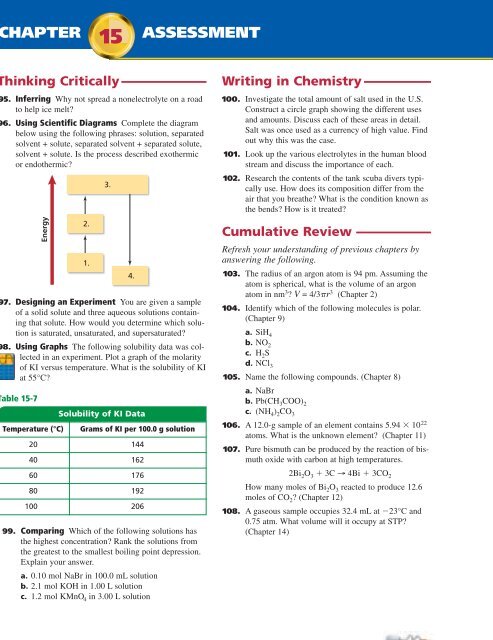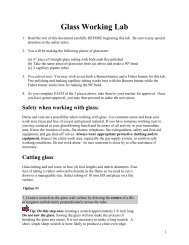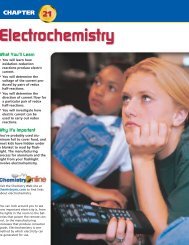Chapter 15: Solutions - Weironline.net
Chapter 15: Solutions - Weironline.net
Chapter 15: Solutions - Weironline.net
You also want an ePaper? Increase the reach of your titles
YUMPU automatically turns print PDFs into web optimized ePapers that Google loves.
CHAPTER <strong>15</strong> ASSESSMENT<br />
Thinking Critically<br />
95. Inferring Why not spread a nonelectrolyte on a road<br />
to help ice melt?<br />
96. Using Scientific Diagrams Complete the diagram<br />
below using the following phrases: solution, separated<br />
solvent + solute, separated solvent + separated solute,<br />
solvent + solute. Is the process described exothermic<br />
or endothermic?<br />
97. Designing an Experiment You are given a sample<br />
of a solid solute and three aqueous solutions containing<br />
that solute. How would you determine which solution<br />
is saturated, unsaturated, and supersaturated?<br />
98. Using Graphs The following solubility data was collected<br />
in an experiment. Plot a graph of the molarity<br />
of KI versus temperature. What is the solubility of KI<br />
at 55°C?<br />
Table <strong>15</strong>-7<br />
Energy<br />
2.<br />
1.<br />
99. Comparing Which of the following solutions has<br />
the highest concentration? Rank the solutions from<br />
the greatest to the smallest boiling point depression.<br />
Explain your answer.<br />
a. 0.10 mol NaBr in 100.0 mL solution<br />
b. 2.1 mol KOH in 1.00 L solution<br />
c. 1.2 mol KMnO4 in 3.00 L solution<br />
3.<br />
486 <strong>Chapter</strong> <strong>15</strong> <strong>Solutions</strong><br />
4.<br />
Solubility of KI Data<br />
Temperature (°C) Grams of KI per 100.0 g solution<br />
20 144<br />
40 162<br />
60 176<br />
80 192<br />
100 206<br />
Writing in Chemistry<br />
100. Investigate the total amount of salt used in the U.S.<br />
Construct a circle graph showing the different uses<br />
and amounts. Discuss each of these areas in detail.<br />
Salt was once used as a currency of high value. Find<br />
out why this was the case.<br />
101. Look up the various electrolytes in the human blood<br />
stream and discuss the importance of each.<br />
102. Research the contents of the tank scuba divers typically<br />
use. How does its composition differ from the<br />
air that you breathe? What is the condition known as<br />
the bends? How is it treated?<br />
Cumulative Review<br />
Refresh your understanding of previous chapters by<br />
answering the following.<br />
103. The radius of an argon atom is 94 pm. Assuming the<br />
atom is spherical, what is the volume of an argon<br />
atom in nm3 ? V = 4/3�r3 (<strong>Chapter</strong> 2)<br />
104. Identify which of the following molecules is polar.<br />
(<strong>Chapter</strong> 9)<br />
a. SiH4 b. NO2 c. H2S d. NCl3 105. Name the following compounds. (<strong>Chapter</strong> 8)<br />
a. NaBr<br />
b. Pb(CH3COO) 2<br />
c. (NH4 ) 2CO3 106. A 12.0-g sample of an element contains 5.94 � 1022 atoms. What is the unknown element? (<strong>Chapter</strong> 11)<br />
107. Pure bismuth can be produced by the reaction of bismuth<br />
oxide with carbon at high temperatures.<br />
2Bi2O3 � 3C → 4Bi � 3CO2 How many moles of Bi2O3 reacted to produce 12.6<br />
moles of CO2 ? (<strong>Chapter</strong> 12)<br />
108. Agaseous sample occupies 32.4 mL at �23°C and<br />
0.75 atm. What volume will it occupy at STP?<br />
(<strong>Chapter</strong> 14)<br />
chemistrymc.com/chapter_test




